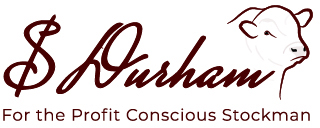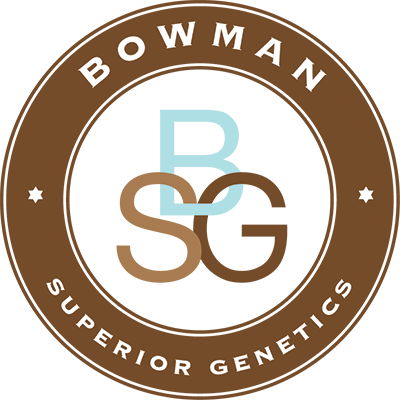
Profitable. Sustainable. Effective. Efficient.
(Even Environmentally Friendly Seedstock.)
“We think this index is the future in terms of finding cattle that excel in all phases of production without going to extremes.”
Scott Loving, Loving Farms
Pawnee Rock, Kansas
“We think this index is the future in terms of finding cattle that excel in all phases of production without going to extremes.”
Scott Loving, Loving Farms
Pawnee Rock, Kansas
While responsible genetic evaluation organizations and their clients gravitate toward seeking out data that balance the complete lifecycle of the beef cow and her offspring in order to find which cattle have more stay power and are therefore more profitable, so too can cattlemen who incorporate the $Durham economic selection index into their genetic selection. This index engages the full suite of profit driving EPDs for an all-purpose approach, pointing out animals that will truly affect the serious rancher’s bottom line.
Stockmen employing modern Shorthorn genetics into their herd aim to utilize the breed to inject maternal function, therefore generating higher-valued replacement females. $Durham recognizes this, and rewards sires whose progeny will excel at calving ease, fleshing ability and built-in longevity, while promoting progressive payweight yet keeping mature size in check. Further, the index considers a balanced, total production scenario where not only are daughters retained as replacement females, but the male calves not kept as bulls are marketed on a carcass grade and yield basis.
Animals that excel at $Durham represent some of the most elite genetics available to return increased profits to the crux of a cattleman’s business with their Shorthorn investment.
PROFIT = Outputs - Inputs
Why the need for a whole lifecycle economic selection index?
For Shorthorns to leave a bigger footprint in the future of the beef industry, the above PROFIT equation is a very important concept to remember. Too often folks only focus on the outputs, i.e. extreme Yearling Weight, monster Ribeye Area, super high Milk –it is natural to assume ‘more is better.’ However, when one boasts about their outputs, like the size of weaned calves for example, we often ponder, “But how much feed did the cows have to consume in order to milk that much to wean such a calf that size?” Or “What were the energy requirements?” Most importantly, “Did all the dams breed back?”
So, considering inputs vs. outputs in the Shorthorn production equation, led BSG to seeking out a way to generate the most profitable Shorthorns we could. This does not mean the most profitable through sale price after marketing efforts (fitting/feeding/sale price) but more of a practice of “Genetic Accounting” or “Breeding Balance Sheet” per se of the beef production enterprise. We had to seek out cattle who were the most profitable for our customer’s (and most importantly, our customers’ customer’s) bottom line.
For more on the importance of “balancing the breeding sheet” or “genetic accounting,” let’s just analyze post-weaning growth (YW) for example…
Don’t get us wrong, we are always looking to add above average gain to our genetic pool. Afterall, every beef animal is sold by the pound at some point in their life. But it is crucial to realize that constant selection for outputs like extreme growth is also selecting for extreme appetite and higher cow maintenance costs—that’s money OUT of your pocket. This happens when one doesn’t select for cattle that will stop growing at two years of age. Further, we also know that that bigger cows wean less pounds per acre of cow exposed compared to her more moderate coworkers—that’s fewer dollars back IN to your pocket. If we can keep mature cow size in moderation, therefore keeping feeding inputs lower on the average cattleman’s budget, while at the same time select for increased – but not extreme – growth, then we are doing our part to generate a herd that will produce more dollars per acre and will do it for a number of years. This idea of balancing growth in Shorthorn production, is just one component of the $Durham index.
…and it all boils down to just making cattle that aren’t only profitable, but also sustainable for your operation’s next generation to carry on your legacy.
Like it or not, the pressure is on to seek out fresher, more sustainable, modern cattle for the business of beef. But in order for any enterprise to be sustainable, they must first be profitable. In order to be profitable, the cattle enterprise must first be effective, then efficient. Knowing this, the incorporation of responsibly designed, whole lifecycle economic selection indexes, like $Durham, is imperative to long term success. Until we can practically measure intake on grasslands and methane outputs in the atmosphere, we all are liable in doing what we can to make a more efficient beef cow. She must breed earlier in her life, calving on her own, raise a biologically balanced calf for optimal growth and moderate mature size who can lay down marbling easier and faster with fewer days on feed. Furthermore, she must do this repeatedly year after year and produce daughters that can do it better in their generation. The good news is that it this is all captured in the $Durham index. So why not be effective at spending fewer dollars on the front end, reaping higher paydays on the back end, and be more efficient with it than you were last year?
BSG sires are all selected based on their $Durham status, and the females are annually culled on lower values.
